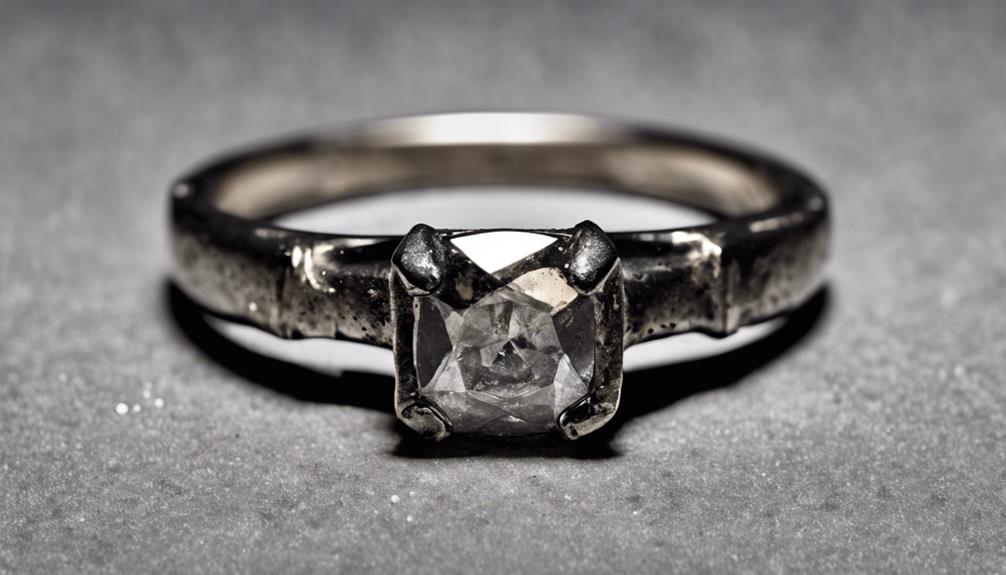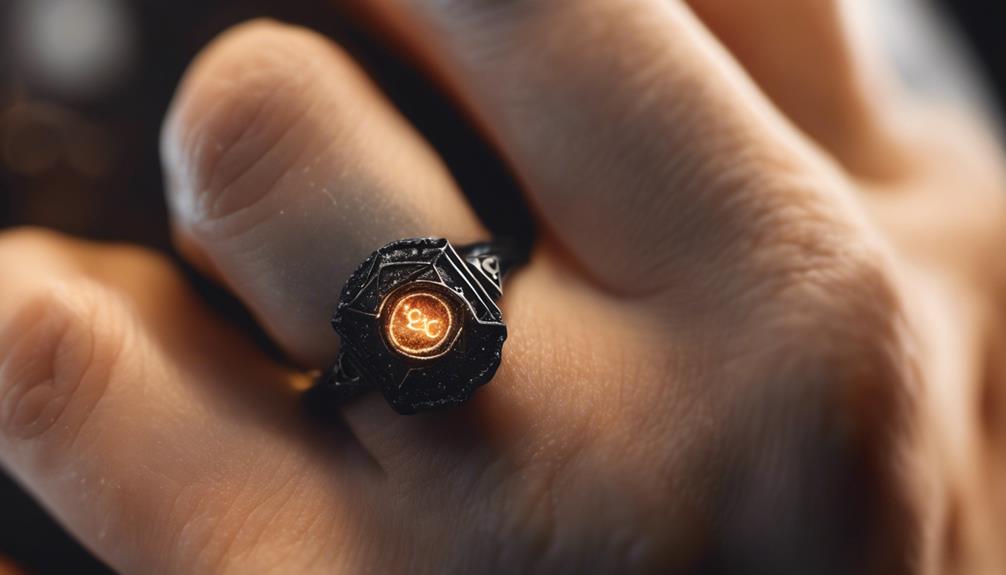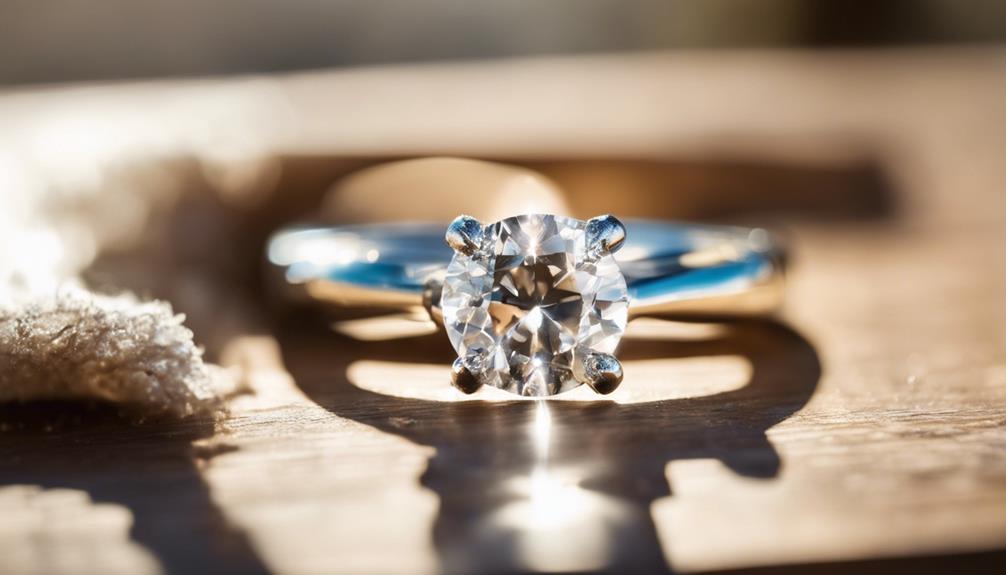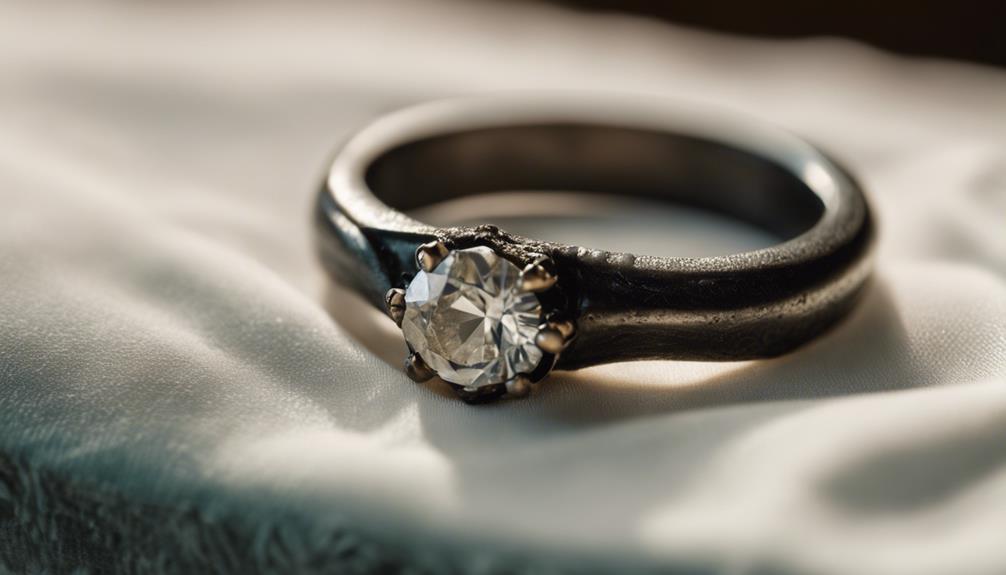Your engagement ring is turning black likely due to a combination of tarnishing from silver sulfide, skin chemistry, and environmental factors. If your ring contains metals like silver or copper, it can react with sulfur compounds or your acidic skin, forming a black tarnish. Sweat, humidity, and exposure to chlorinated water or harsh chemicals can accelerate this process. Even lotions and cosmetics contribute to discoloration. Regular cleaning and proper storage can help maintain its shine. Curious to explore how to prevent this and keep your ring looking new? Stay tuned for more insights on tackling ring discoloration effectively.
Causes of Ring Discoloration

The gleam of your engagement ring can lose its luster due to several factors, primarily involving the metals it’s made from. Rings often contain metal alloys like copper, silver, and nickel, which can lead to discoloration. When exposed to sweat or environmental elements, these metals can corrode, resulting in that dreaded black dust. This can cause the ring to leave unwanted marks, turning your finger an unsightly color.
Corrosion of the metals in your ring is a common culprit. When you engage in everyday activities, your ring comes into contact with various substances. Chlorinated water from swimming pools, harsh cleaning chemicals, and even your own body sweat can accelerate this corrosion. The salts and acids present in sweat can further react with the metals, causing them to tarnish over time.
Additionally, factors like humidity and heat can exacerbate skin reactions, making the ring fit tighter and promoting more contact with skin oils. This close contact can lead to metallic abrasion, where dark residues transfer onto your skin from the ring.
Cosmetics, lotions, and soaps can also contribute to this issue, leading to further discoloration.
Role of Sulphidation
Understanding the role of sulphidation in your engagement ring’s discoloration is key to addressing the issue. When silver in your ring comes into contact with sulfur compounds in the environment, a chemical reaction called sulphidation occurs. This reaction forms silver sulfide, resulting in the black tarnishing you’ve noticed.
It’s common and doesn’t reflect poor quality silver; it simply highlights the metal’s natural properties when exposed to sulfur.
Factors such as high humidity, acidic skin pH, and contact with sulfur-containing products like certain lotions and perfumes can accelerate this corrosion process. If you live in coastal areas or places with high pollution, environmental sulfur levels can be higher, speeding up the tarnishing.
To combat this, regular cleaning and proper storage of your silver ring are essential. By doing so, you can help maintain its shine and slow down the sulphidation process.
Use a gentle silver cleaner and store your ring in a dry, airtight container when not wearing it. These small steps can make a big difference in preserving your beloved ring’s appearance and keeping that unwanted black discoloration at bay.
Impact of Skin Chemistry

Your skin chemistry plays an essential role in how your engagement ring reacts and potentially discolors. The way your skin interacts with the metals in your ring can lead to unexpected changes, like your beloved jewelry turning black.
Here’s how this happens:
- Acidity Levels: If your skin has higher acidity, it can corrode metal alloys, especially in gold rings, leaving a black residue.
- Unique Body Oils: Some people have oils or acids that react with metals like copper and nickel, leading to discoloration on your fingers.
- Diet and Hormonal Changes: These can influence your skin’s pH levels, impacting how your ring interacts with your skin.
- Health Conditions: Conditions like anemia might alter your skin chemistry, increasing the chances of your ring turning black.
- Individual Differences: Your personal body chemistry might react differently with jewelry materials compared to someone else.
Understanding these factors can help you manage and prevent discoloration.
Since your skin’s reaction to metals varies, noticing how your ring behaves on your fingers can guide you in choosing the best metal type.
Consider these influences to maintain your ring’s shine and avoid turning it black.
Environmental Influences
Many environmental factors can contribute to your engagement ring turning black. High humidity is a major culprit, trapping moisture that leads to tarnishing and discoloration.
If you live in a coastal area, the salt and chlorine in the air can accelerate corrosion of the metal alloys in your ring. This corrosion is due to the natural reaction between these elements and the metals, causing them to oxidize and darken over time.
Heat is another factor that can affect your ring. It causes your ring to fit more snugly, increasing contact with your skin. This can enhance the reaction between your skin acids and the ring, leading to further tarnishing.
Additionally, chemical exposure from everyday products like cleaning agents, lotions, and cosmetics can also cause the metals in your ring to oxidize. These chemicals can react with the metals, contributing to the blackening effect you might notice.
To combat these environmental influences, it’s important to be mindful of the conditions your ring is exposed to. While it’s a normal chemical reaction, understanding these factors can help you take steps to minimize tarnishing and keep your ring looking its best.
Maintaining Ring Shine

To maintain the shine of your engagement ring, it’s essential to develop a regular cleaning routine, which can effectively remove dirt, sweat, and chemical residues that contribute to tarnishing.
Regular cleaning helps prevent the metals in your gold from starting to corrode and turn black. Here are some tips to help you maintain that sparkle:
- Clean your rings: Use a soft cloth and a suitable jewelry cleaner regularly to keep your ring gleaming.
- Protect with clear nail polish: Apply it to the inner band as a barrier against skin reactions that can lead to corrosion.
- Store properly: Keep your ring in a dry, cool place, like a fabric-lined jewelry box, to limit exposure to humidity and environmental factors.
- Inspect often: Check for any signs of wear or damage, such as loose settings or scratches, which can trap dirt and lead to tarnishing.
- Avoid harsh chemicals: Steer clear of exposing your ring to cleaning agents and beauty products that might react with the metal alloys and dull its shine.
Conclusion
To keep your engagement ring shining, focus on prevention and regular care. Clean it gently with a soft cloth and avoid exposure to harsh chemicals and lotions. Store your ring in a dry place when you’re not wearing it, and consider professional cleaning if needed. Remember, the black tarnish is a common, natural occurrence, not a flaw in your ring. With a bit of care, your ring will continue to sparkle and symbolize your special bond.



